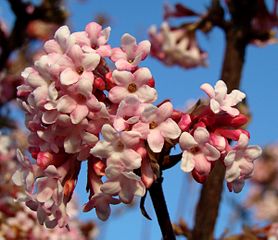pH - Why is it important for rhododendrons?
What is pH, and how do I obtain the proper pH for my rhododendrons?
The term "pH" refers to the acidity of a material. Technically, it is a measurement of the hydrogen ion content. The pH scale ranges from 0 to 14 and pHs of 0 to 7 are acidic - pHs of 7 to 14 are referred to as being basic or alkaline. A pH of 7 means the material is neutral.
The experts indicate rhododendrons prefer an acidic medium. The preferred pH should be between 4.5 and 6.5.
It is almost impossible for a layperson to determine the pH of the potting medium they use. There are pH meters on the market...but in my experience the ones that cost less than $100 are practically worthless. I have yet to try one that is better than plus or minus 1 pH.
But...all is not lost. It is actually fairly easy to get your pH in the desired range. Fir or hemlock bark is almost always in an acceptable range and, therefore, an ideal medium to use. It is best if the bark has decayed or mulched for six months prior to use.
The reason pH is important for plants has to do with the intake of minerals and nutrients. If the pH is too low, yes, soil can be too acidic, the plants have difficulty taking in the nitrogen and phosphorous they need for growth.
The foliage will not be the rich green that you expect. Adding lime to the medium or the soil will raise the pH and help this condition. Too low pH can occur when soil has been fertilized heavily for years. The fertilizer frequently increases the acidity of the soil...that is...it lowers the pH.
If the planting medium of soil is too alkaline, i.e. the pH is too high, it usually causes iron and/or manganese deficiencies. These deficiencies result in chlorosis - a condition where the veins may remain dark green - but the spaces between the veins will be yellow...the leaves are said to be chlorotic. To remedy this condition sulfur is often applied for a quick fix. Good mulching will also help in the long run. A decomposed mix that would not use up the nitrogen in your fertilizer is best.
In summary, pH is important but your plants will tell you if you have a problem. Generally, it is always best to use bark in pots and bark or pine needle mulch as an additive for your soil...and you will rarely have a problem.
Companion Plant: Viburnum bodnantense
The winter-flowering Bodnant viburnums are tall, fairly narrow shrubs which have bunches of tubular pink flowers on leafless stems. They bloom in late winter and have frost-resistant blooms which stay for weeks and are quite fragrant.
The species name 'bodnantense' refers to Bodnant Gardens, North Wales, where the hybrid was raised in 1935. The Bodnant vibumum grex (a grex denotes all the offspring of a particular cross) is a cross of the Chinese viburmum farreri with the Himalayan viburnum grandiflorum and, includes the cultivars 'Dawn', 'Charles Lamont', and 'Debian'.
'Dawn'...often called 'Pink Dawn'... is commonly grown and is widely available. 'Charles Lamont' has dark pink flowers which are somewhat larger than 'Dawn'. 'Debian' is tall and has a stiff habit with slightly fragrant whitish flowers which turn red with age.
'Dawn' is a deciduous upright shrub, 2-4 m. (6-12 ft) in height. It blooms in Fall and Winter after the leaves have fallen. Before they fall, the leaves turn a burnished bronze color. Red buds open to fragrant pink flowers that fade to white flushed with pink as they age. Wet weather and frosts may limit flowering display. Branches can be forced inside for a winter bouquet. The fragrance indoor may be somewhat overpowering.

Photo by Giraffenigel
'Dawn' is not particular as to its location, liking sun, but also doing well in partial shade. It enjoys acid, well-drained soil, but does well enough in other soils. It is fairly cold-hardy...but requires a protected placement where the chilliest winds won't hit it at temperatures below zero degrees F. Overall, this hybrid is very adaptable.
Since the plants are fragrant, grow them near a path you are like to use frequently. You will be rewarded! Otherwise, you won't appreciate the scent at a time of year when you're less inclined to go down a damp cold garden to smell it. The flowers have a pleasing perfume. The new leaves get so large that the blooms occurring the rest of the year can pass unnoticed. The leaves smell like citrus if crushed or bruised.